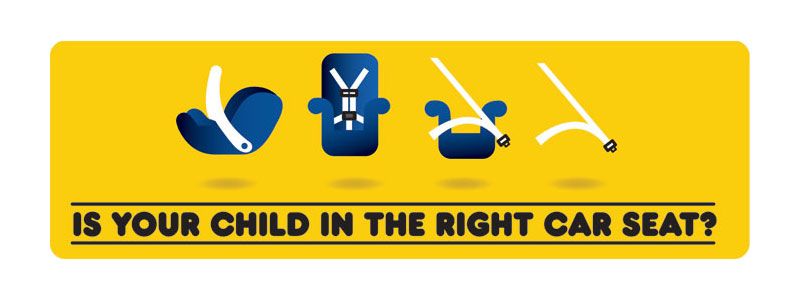Child Passenger Safety

Is Your Child in the Right Car Seat?
Car accidents are the number one killer of children in the United States.
The state of Kansas has child restraint laws for children under the age of 8 (as defined in KSA 8-1344.)* Ages 3 and under are required to be in a car seat with a harness, and ages 4 through 7 who are less than 80 pounds or 57 inches must be in a car seat or a booster seat. Ages 8 and over (including adults) must wear a seatbelt.
*Kansas is a proper-use state, which means that misusing a car seat is illegal. Make sure you choose the correct seat for your child.
Please note that these are minimums. To maximize occupant protection, child passenger safety advocates recommend the following:
Rear-face as long as possible.
A broken neck or internal decapitation in a forward-facing 1-year-old during even a minor accident is a possibility, as the cervical spine does not begin complete ossification until between the ages of 3 years and 6 years.
The American Academy of Pediatrics (AAP) and the National Highway Traffic Safety Administration (NHTSA) recommend rear-facing to the limits of your convertible car seat.
Harness your child until developmentally ready/mature enough to move to a booster.
A five-point harness keeps children properly positioned in their seats at all times and distributes the crash forces across the torso. The AAP and NHTSA recommend harnessing until the seat is outgrown by height and/or weight.
Boosters are for children who are at least 4 years of age and can stay properly positioned the entire ride. High-back boosters provide extra side impact protection and are acceptable for children who have outgrown their harnessed car seats. Backless boosters are recommended once children have outgrown high-back boosters. Without a booster seat, the lap belt hits the soft part of the child's abdomen, causing internal injuries and often death in an accident.
Seatbelts are fitted to adult bodies. Children should only be out of a booster and in a seatbelt alone if they can sit all the way back against the auto seat, legs bent at the edge of the auto seat, shoulder belt crossing between neck and arm completely on the shoulder, lap belt crossing between the hip bones and thighs (not the abdomen), and they can sit in this position throughout the entire ride. These steps are referred to as the five-step test, and most children pass this test between the ages of 10 and 12.
A quick overview of child restraints:
Infant seats (bucket carriers with a handle) are to be used rear-facing only.
Convertible seats can be used both rear-facing and forward-facing.
Combination seats can be used foward-facing only, either with the harness or with the seatbelt as a booster.
Booster seats, also called belt-positioning boosters, are to be used with a lap/shoulder belt.
Did you know?
At least 80% of parents/caregivers believe they have their seats installed and used correctly, but 90%+ of them don't!
***Please read the manual for each separate child restraint you are using. All restraint instructions are not created equal.***
For an excellent pictorial on proper car seat usage, please click here.
Finally, remember:
You are only as safe as the most dangerous driver on the road. Give yourself and your passengers as much protection as possible.
Resources:
Babycenter Car Seat Questions
Car-Seat.org
CPST Locator
IIHS Best Booster List
IIHS Individual State Car Seat Laws
NHTSA
Recommended Car Seats
Safe Kids
For more information on child passenger safety or to schedule a free car seat check, please contact certified Child Passenger Safety Technician, Jennifer Shipp, at 785-221-6416 .